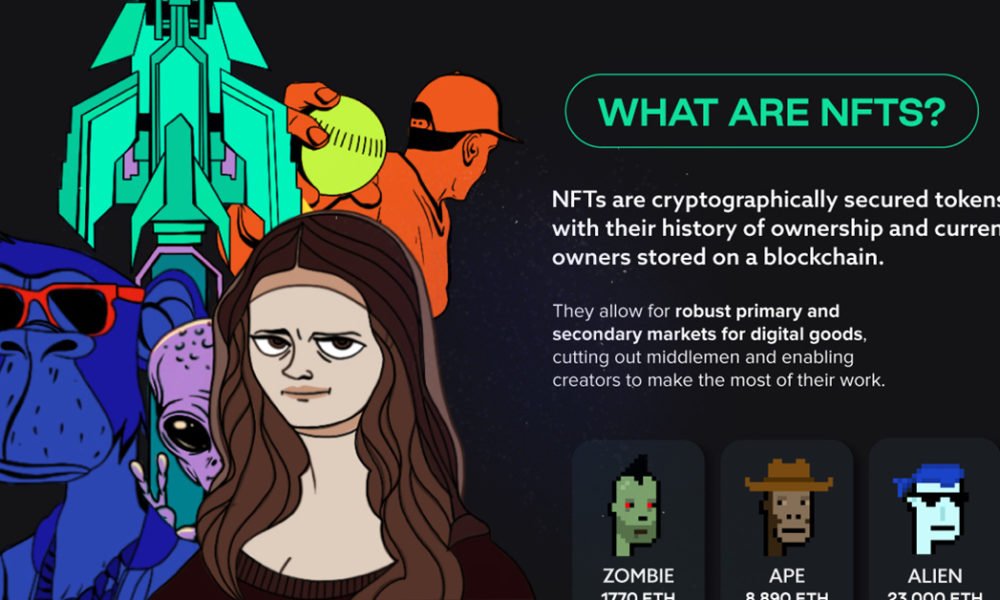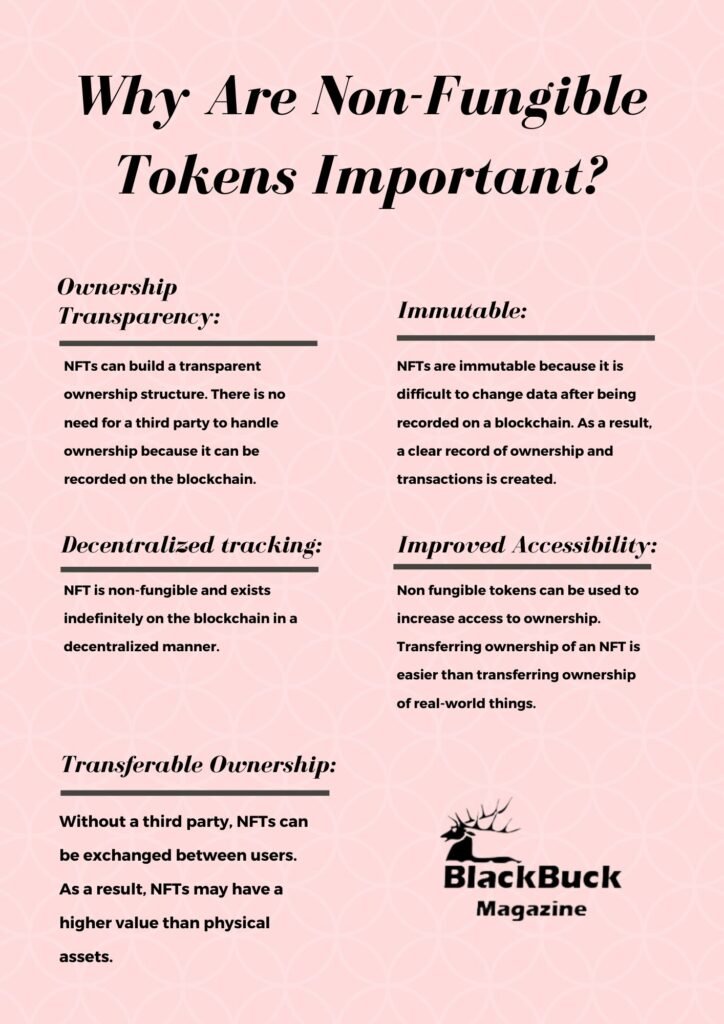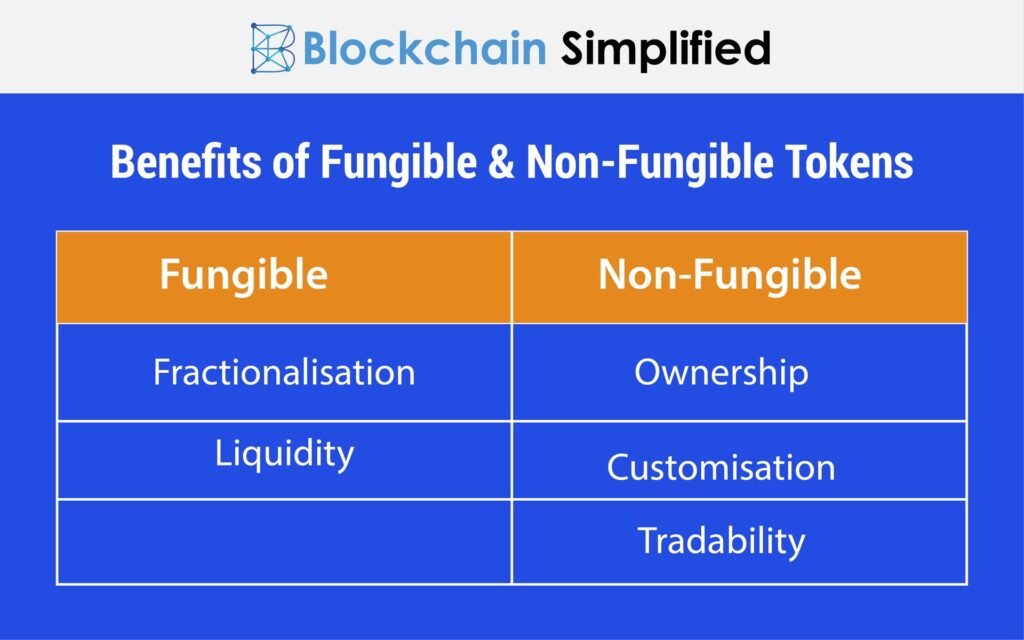What exactly are nonfungible tokens? It’s a question everyone is considering as the value of digital art skyrockets. Even though NFTs have been around for a few years, it took Beeple, CryptoPunks, and Bored Ape Yacht Club to put them on the map. Since then, Adidas, Nike, Disney, McDonald’s, and several celebrities have all come on board with NFTs. NFT means in simple words – they are digital assets whose ownership is traceable on NFT blockchain development platforms.
If you’re curious how much of an influence these digital assets have, Influencer Marketing Hub has compiled a list of data. One such statistic includes that the “Costliest” NFT was sold for $532 million. Moreover, in the third quarter, NFT trading volume increased to about $11 billion. Besides, the majority of NFTs are sold for under $200.
Let’s dive deeper and get to know NFT’s meaning.
Table of Contents
- What Is NFT?
- Why Are Non-Fungible Tokens Important?
- How do NFTs work?
- What Is The Difference Between Non-Fungible Tokens And Cryptocurrency?
- Are NFTs The Next Big Thing In The Future?
- How Many NFTs Are There, And What Are The Few Examples Of NFTs?
- FAQs About NFT
- Conclusion
What Is NFT?

Non-fungible assets tokens are unique digital assets whose ownership can be tracked on NFT blockchain development like Ethereum. Fungible assets or fungibility denotes an item or an asset that can trade or be exchanged with a similar type of asset or good.
Each Non fungible token, unlike a bitcoin unit, is unique; thus, it cannot be swapped like-for-like. As a result, NFTs, like conventional art, have grown into collectible digital objects with monetary value.
Because each non-fungible tokens asset is unique in its own right, NFTs cannot be copied or equated with a comparable asset.
Any replicated digital file can be stored as an NFT to identify the original copy. NFTs may be generated from any photography, art, audio, or video file. They are most seen or read about in the context of psychedelic, futuristic motion artworks. Tweets and memes have even been used to construct NFTs.
NFT tokens may be manufactured from almost any unique item that can be stored and has value.
Why Are Non-Fungible Tokens Important?
The cryptocurrency ecosystem is evolving. Several tokens, coins, currencies, and assets are accessible, each with its unique worth. NFTs, or non-fungible tokens, are non-fungible cryptocurrency tokens that are indivisible and distinct.
NFTs may be used to generate digital collectibles and represent real-world items. The following are some of the reasons why NFTs are so significant.

How do NFTs work?
It is established that to show ownership of something digital, a transparent, immutable ledger is required. It keeps track of all NFTs, who owns them, and where the files they refer to are stored. It allows anybody to examine the legitimacy of any NFT at any moment.
Each time an NFT is moved or generated, the activity is recorded on the blockchain and timestamped. It allows you to track any single NFT back to its origins.
Although crypto assets may be built from scratch, most developers will leverage an existing blueprint to speed the process and save money when launching tokens.
Other notable blockchains, like Eos, Neo, and Tron, have developed their own NFT tokens specifications to encourage developers to create and host NFTs on their networks.
What Is The Difference Between Non-Fungible Tokens And Cryptocurrency?

NFT tokens and cryptocurrencies are built on the blockchain and use comparable innovation and standards. As a result, they will attract similar players. NFTs are a subset of crypto culture, and you’ll almost need cryptographic forms of money to trade them.
- Cryptocurrency:
A cryptocurrency is encrypted digital or virtual money, making counterfeiting and double-spending impossible. Many cryptocurrencies are built on blockchain technology. It is a distributed ledger enforced by a global network of computers.Cryptocurrencies differ from traditional currencies because a central body does not issue them. It makes them less vulnerable to government intervention or manipulation. - Non-fungible tokens:
Non-fungible tokens are one-of-a-kind digital assets that address certifiable items like photos, music, movies, and trading cards. They’re kept in a digital ledger and exchanged via the internet. NFTs may be generated and purchased for any digital asset, such as advanced collectible characters, virtual land, or individual online media postings.
Are NFTs The Next Big Thing In The Future?
The artist’s work known as Beeple made revenue of $69.3 million. This was enough to grab the people’s interest in NFTs.
NFTs let artists create and disseminate art through internet channels, circumventing conventional gatekeepers that have controlled what art is and who has access to it for decades. Artists may also be directly funded by their fans and have control over their careers thanks to blockchain transactions.
According to analysts, numerous causes led to the rise of NFTs in 2021, and the increasing popularity of NFTs demonstrates the unexpected adoption curve of new technologies. Because of the Bitcoin and Ethereum bull runs in 2021, many new investors rushed to crypto.
NFTs can be traded, but their long-term worth for investors and businesses is unclear.
How Many NFTs Are There, And What Are The Few Examples Of NFTs?
Nowadays, NFTs are a fascinating new method of owning digital assets. There were over 7,000 distinct types of cryptocurrencies on the market by the end of October 2021.
Please look at some of the NFT examples to see what makes them unique.
• Grimes WarNymph: Grimes, a composer, received $5.8 million from the sale of 10 NFTs. The most valuable object sold for $389,000 at auction. It was a one-of-a-kind film named “Death of the Old.”
• Glenfiddich whisky: The distillers, William Grant and Son, recently sold 15 bottles of 46-year-old Glenfiddich whisky for $18,000 each, each with its own NFT artistic rendition of the bottle. The NFT serves as a counterfeit-proof certificate of ownership and allows the owner to brag about their acquisition.
• Furniture NFTs: Andrés Reisinger, an Argentinian designer, produces NFT furniture that may be used in open environments like Decentraland or Minecraft. Reisinger’s most expensive piece sold for a little around $70,000.
• RTFKT’s digital sneakers: RTFKT offers virtual shoes for gamers’ online gaming avatars for much to $10,000 per pair. RTFKT made $3.1 million in only a few minutes in March 2021 by selling a pair of sneakers he co-designed with another artist named Fewocious.
• Nyan Cat: In a maiden excursion into NFTs for creator Chris Torres, a crypto art recreation of the renowned GIF Nyan Cat meme went for $590,000 in an online auction.
FAQs About NFT
1. What is NFT, and where did it come from?
In May 2014, the first NFT – Quantum – was released. It’s a pixelated octagon in a fascinating shifting colors and patterns cycle. Artist Kevin McCoy created it. Quantum was sold for $1.4 million in November 2021.
2. What are NFT markets, and how do they work?
NFT markets are blockchain-based platforms where artists and designers may exhibit their work. Enthusiasts can bid on these NFTs in a time window set by the vendor, with the highest bidder receiving the artwork.
The platform charges the seller a small fee known as gas fees/energy costs to complete the transaction, and the blockchain may charge the buyer a minor transaction fee. The owner receives an NFT token with their data coded in it after making a payment in the platform’s native coin.
The NFT can be used to track down the artwork’s first owner and even the artist. It continues to update as the NFT’s owner changes.
3. What are the best staking platforms for NFTs?
Art owners may enjoy possessing a valuable digital asset by staking NFTs. Users pledge their NFT to the network as a stake in its development, and they are compensated in exchange for contributing their valued resources. Some of the most excellent NFT staking platforms are as follows:
- Splinterlands
- NFTX
- BAND NFTs
- Doge Capital
4. Is it possible to convert Non fungible tokens into cash?
An NFT, like a piece of art, may be sold for cash or cryptocurrency.
But, like bitcoin, the token’s asset transfer is recorded in the blockchain. This determines who owns it right now. Each NFT is linked to the original owner’s digital (or, in certain circumstances, physical) asset.
5. What happens once you buy NFT?
When you buy an NFT, you receive the keys to a non-fungible – and unique – token. In Decentraland, the token is yours to trade, hold, and display. The third argument is that the digital file associated with an NFT is as easy to copy, paste, and download as any other.
6. Is there genuine money in NFT?
A digital asset that depicts real-world elements like art, music, in-game goods, and films is known as a Non-Fungible Token. They’re bought and traded online. It often uses cryptocurrency, and they’re usually encoded with the same software as many other cryptos.
Conclusion
The bottom line is that Nonfungible tokens have risen in popularity over the last year, inviting thousands of people to join the bandwagon. One of the reasons for this is that they are verifiable, allowing merchants to verify their legitimacy. This is a unique invention that lends credibility to the market.
NFT crypto art, in particular, is reshaping the art industry by offering a new and exciting way for creators, artists, fans, and investors to collaborate. Many people consider it the next frontier of income-generating because of its great possibilities.
